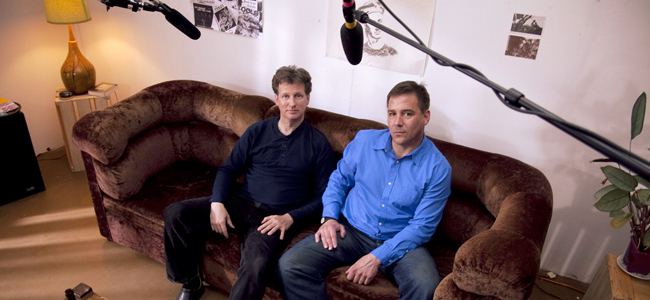
Do you remember those things called cassette tapes? If you were born after 1995 you may not be familiar with recording medium that predated the CD, but before the internet existed it was the popular format to trade with friends and share mix-tapes of both music and audio verité. What is audio verité you ask? In the late 80s there was phenomena between underground tape collectors to share candid content of people simply talking, usually involving some kind of revelatory insight into their real character. An example from the film would be Orson Welles outtakes from a radio commercial he made for snow peas, cussing out the audio engineer and showing his true colors. Interestingly enough, the subject matter of Shut Up! Little Man centers on two old curmudgeons who after verbally bashing one another become a viral sensation before the existence of the Internet.
In 1987, two young college graduates Eddie Lee Sausage and Mitch Deprey moved from Wisconsin to San Francisco into an apartment adjacent two elderly gentlemen, Peter Haskett and Raymond Huffman. Due to the thin walls, they couldn’t help but overhear their neighbors drunkenly berate each other constantly, as Ray, a blatant homophobe, would castrate his roommate Peter, a blatant homosexual, who would cut him down to size with quick retorts. The constant bickering proves to be a continual and irritating affair until one day, Eddie wanting to confront his neighbors and asks them to keep it down. The response is a death threat from Ray, which prompts Eddie to worry that something bad might happen.
In fact quite the opposite occurs as the two young stoners, using a ski pole and microphone, begin to record the old gentlemen bickering as if they were married couple. The key phrase repeated by Pete to Ray’s constant belligerent attacks, is shut up little man, mixed with other colorful language. The pair continue to record Pete and Ray’s arguments and start to build a collection of tapes that they begin to share with their friends. What happens next is a remarkable phenomena, the tapes start to go viral in what mint be the first pop-culture sensations in a pre-internet era, through an underground network of cassette traders. This leads the audio into the hands of comic book artists (Ghost World artist Daniel Clowes), playwrights and movie producers (Henry Rosenthal) turning the voyeuristic tapes into entertainment for the world to share.
The films style is reminiscent of The Kid Stays in the Picture, where director Matthew Bate creates visual photographs and animations that leap off the screen. It’s also interestingly contrasted with the viral nature of the Internet and how that has changed the human condition to perceive other peoples misfortune or rather their true colors. Visually engaging, compelling interviews and heartfelt moments elevate this documentary into an ether of socially relevant content as an interesting take on how one persons argument can turn into a world of enjoyment for everyone else.
